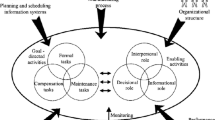Abstract
This paper is concerned with the shift scheduling problem involving multiple breaks with different durations and multiple break windows for each shift. We have incorporated ideal break periods and ideal waiting time into the original problem previously presented in the literature. As an extension of the implicit integer programming model with a single goal of minimizing the labor cost, we have proposed an implicit preemptive goal programming model involving three goals, which are given in order of their priority levels as follows: (1) minimize the labor cost; (2) maximize the number of employees that receive their breaks at ideal break periods; (3) make the waiting times of the employees between their consecutive breaks equal to the ideal waiting time, i.e. minimize the deviations from ideal waiting time. The ideal waiting time is incorporated into the model implicitly by matching the periods within the break windows. We aim at improving the break schedules through a more sensitive timing of the breaks, without causing an increase in the labor cost. The computational results obtained on randomly generated test problems indicate that the extended model may yield considerable improvement in the break placement.

Similar content being viewed by others
References
Addou I, Soumis F (2007) Bechtold-Jacobs generalized model for shift scheduling with extraordinary overlap. Ann Oper Res 155(1):177–205
Alfares HK (2004) Survey, categorization, and comparison of recent tour scheduling literature. Ann Oper Res 127(1–4):145–175
Al-Yakoob SM, Sherali HD (2007) Multiple shift scheduling of hierarchical workforce with multiple work centers. Inform 18(3):325–342
Aykin T (1996) Optimal shift scheduling with multiple break windows. Manag Sci 42(4):591–602
Aykin T (2000) A comparative evaluation of modeling approaches to the labor shift scheduling problem. Eur J Oper Res 125(2):381–397
Baker KR (1976) Workforce allocation in cyclical scheduling problems: a survey. Oper Res Q 27(1):155–167
Bechtold SE, Brusco MJ (1994) A microcomputer-based heuristic for tour scheduling of a mixed workforce. Comput Oper Res 21(9):1001–1009
Bechtold SE, Jacobs LW (1990) Implicit modeling of flexible break assignments in optimal shift scheduling. Manag Sci 36(11):1339–1351
Bergh JVd, Beliën J, Bruecker PD, Demeulemeester E, Boeck LD (2013) Personnel scheduling: a literature review. Eur J Oper Res 226(3):367–385
Brusco MJ, Jacobs LW (2000) Optimal models for meal-break and start-time flexibility in continuous tour scheduling. Manag Sci 46(12):1630–1641
Brusco MJ, Johns TR (1995) Improving the dispersion of surplus labor in personnel scheduling solutions. Comput Ind Eng 28(4):745–754
Côté MC, Gendron B, Rousseau LM (2011) Grammar-based integer programming models for multiactivity shift scheduling. Manag Sci 57(1):151–163
Dantzig GB (1954) A comment on Edie’s “Traffic delays at toll booths”. Oper Res 2(3):339–341
Edie LC (1954) Traffic delays at toll booths. J Oper Res Soc Am 2(2):107–138
Ernst AT, Jiang H, Krishnamoorthy M, Sier D (2004a) Staff scheduling and rostering: a review of applications, methods and models. Eur J Oper Res 153(1):3–27
Ernst AT, Jiang H, Krishnamoorthy M, Owens B, Sier D (2004b) An annotated bibliography of personnel scheduling and rostering. Ann Oper Res 127(1–4):21–144
Gaballa A, Pearce W (1979) Telephone sales manpower planning at Qantas. Interfaces 9(3):1–9
Hojati M, Patil AS (2011) An integer linear programming-based heuristic for scheduling heterogeneous, part-time service employees. Eur J Oper Res 209(1):37–50
Jacobs LW, Bechtold SE (1993) Labor utilization effects of labor scheduling flexibility alternatives in a tour scheduling environment. Decis Sci 24(1):148–166
Lin HT, Chen YT, Chou TY, Liao YC (2012) Crew rostering with multiple goals: an empirical study. Comput Ind Eng 63(2):483–493
Loucks JS, Jacobs FR (1991) Tour scheduling and task assignment of a heterogeneous work force: a heuristic approach. Decis Sci 22(4):719–738
Moondra SL (1976) An LP model for work force scheduling for banks. J Bank Res 7(4):299–301
Rekik M, Cordeau JF, Soumis F (2004) Using Benders decomposition to implicitly model tour scheduling. Ann Oper Res 128(1–4):111–133
Rekik M, Cordeau JF, Soumis F (2010) Implicit shift scheduling with multiple breaks and work stretch duration restrictions. J Sched 13(1):49–75
Rong A (2010) Monthly tour scheduling models with mixed skills considering weekend off requirements. Comput Ind Eng 59(2):334–343
Segal M (1974) The operator-scheduling problem: a network-flow approach. Oper Res 22(4):808–823
Thompson GM (1995) Improved implicit optimal modeling of the labor shift scheduling problem. Manag Sci 41(4):595–607
Thompson GM (1996) Optimal scheduling of shifts and breaks using employees having limited time-availability. Int J Serv Ind Manag 7(1):56–73
Thompson GM, Pullman ME (2007) Scheduling workforce relief breaks in advance versus in real-time. Eur J Oper Res 181(1):139–155
Topaloglu S (2006) A multi-objective programming model for scheduling emergency medicine residents. Comput Ind Eng 51(3):375–388
Topaloglu S, Ozkarahan I (2002) Implicit optimal tour scheduling with flexible break assignments. Comput Ind Eng 44(1):75–89
Topaloglu S, Ozkarahan I (2004) An implicit goal programming model for the tour scheduling problem considering the employee work preferences. Ann Oper Res 128(1–4):135–158
Author information
Authors and Affiliations
Corresponding author
Rights and permissions
About this article
Cite this article
Sungur, B., Özgüven, C. & Kariper, Y. Shift scheduling with break windows, ideal break periods, and ideal waiting times. Flex Serv Manuf J 29, 203–222 (2017). https://doi.org/10.1007/s10696-015-9234-2
Published:
Issue Date:
DOI: https://doi.org/10.1007/s10696-015-9234-2




